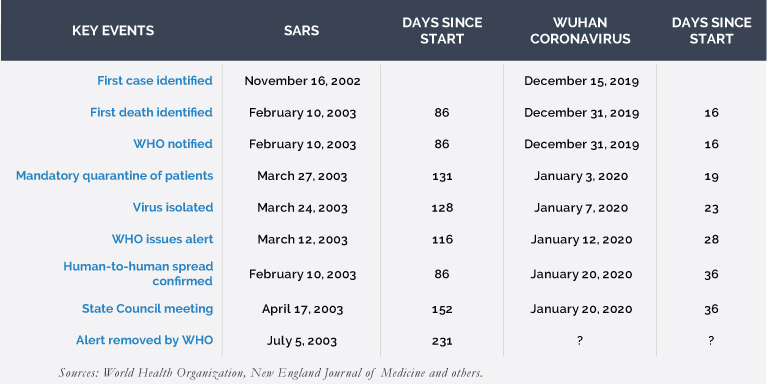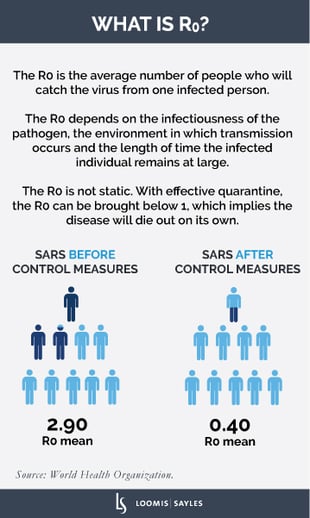There is no shortage of alarming and depressing news when reading about the Wuhan coronavirus. The World Health Organization has declared a global health emergency. There are still many unknowns, but there are some indications that the outbreak may not be as severe as our worst fears. Here’s what I’ll be watching as the outbreak unfolds.
China’s response
China’s response has been significantly swifter than its response to the severe acute respiratory syndrome (SARS) outbreak in 2003. There seems to be little evidence of Chinese authorities deliberately misrepresenting or concealing data related to this outbreak, which was a widespread concern during the SARS episode. The response to the epidemic has also been much more decisive, as the Chinese government has been taking unprecedented drastic measures to stamp out the virus as soon as possible, including closing 17 cities and quarantining about 50 million people.[1]

With the virus dominating the news cycle worldwide for over a week now, China’s people have been taking more precautions (such as wearing face masks and staying home). These measures may reduce transmission substantially[2] and milder symptomatic cases are more likely to be reported, reducing the days from symptoms to isolation.
The virus’ contagiousness

Though there are some signs that the Wuhan coronavirus may be more contagious than SARS, there have been fewer super-spreading events (when one person spreads the virus to 20-100 others instead of the average 2-4).[3] When control measures were implemented for SARS, its R0, a measure of contagiousness, dropped to a level that let the virus die out on its own.[4] For the Wuhan coronavirus, the net effect could result in a similar overall R0, suggesting a similar outcome. So far, most estimates of the Wuhan coronavirus’ contagiousness are not so different from SARS.'
Contagiousness during incubation
There has been lots of speculation that the Wuhan coronavirus may be contagious during the incubation period. This is a worrisome prospect, because it means that infected people could spread the virus before they know they’ve been infected. However, the research indicates this is not a sure thing.[5][6]
The fears about contagiousness during incubation stem from one study investigating one family. While the study found one out of four people infected may have spread the virus asymptomatically, it’s important to note that this was a not a key finding of the study.[7] Most scientific papers identify an incubation period ranging from three to seven days, very similar to that of SARS.[8] Furthermore, the CDC does not think asymptomatic transmission is a concern at this time.[9] We are watching for more academic research that can shed light on the incubation period.
The economic implications
It’s too early to determine the virus’ long-term impact, but at the very least, we’ll likely see a severe, short-term impact on economic activity in China and peripheral nations. The severity of the slowdown will depend on how long it takes to contain the virus. If the virus is contained in the next few weeks, there are good odds of a recovery from any short-term weakness. On the other hand, if the number of cases in economic hubs like Shanghai, Beijing and Hong Kong begins to rise rapidly, or if the spread accelerates outside of China, the economic slowdown could be more widespread and longer-lasting.

[1] https://www.reuters.com/article/us-china-health-who-idUSKBN1ZM1G9
[2] [5] [7] Chan, J, Yuan, S., et al. (2020, January 24). A familial cluster of pneumonia associated with the 2019 novel coronavirus indicating person-to-person transmission – a study of a family cluster. The Lancet.
[3] Riou, J., Althaus, C. (2020, January 24), Pattern of early human-to-human transmission of Wuhan 2019-nCoV. bioRxiv.
[4] World Health Organization. (2003). Consensus document on the epidemiology of severe acute respiratory syndrome (SARS).
[6] [9] Transcript of 2019 Novel Coronavirus (2019-nCoV) Update Press Briefing. (2020, January 27)
[8] Li, Q., Guan, X., et al. (2020, January 29). Early Transmission Dynamics in Wuhan, China, of Novel Coronavirus–Infected Pneumonia. The New England Journal of Medicine.
MALR024830






